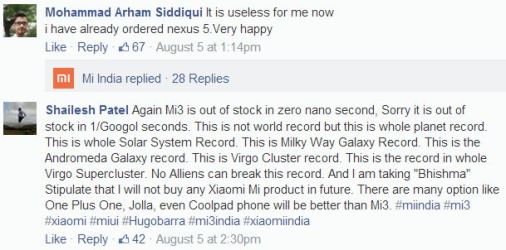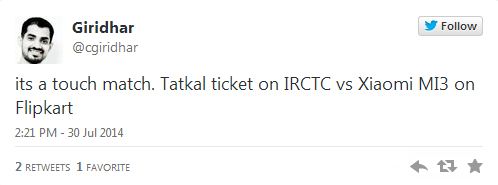India is currently one of the fastest growing handset markets in the world. According to a recent report by wearesocial on Social, Digital and Mobile landscape in India, it was found that in a population of more 1.25 billion, only 349 million are the unique mobile phone users which account to only 28% of mobile penetration. This itself suggest the BIG opportunity that the country will provide in near future to all the handset manufacturers across the world to sell their products and make a lot of money. There was a time when almost every household had a Nokia phone but owing to its persistence for focusing only on feature phones without double-sim functionality as well as non-android based smart-phones, its market share fell which provided an opportunity to other players like Samsung to enter & grow in the smartphone category rapidly. This also gave an opportunity to some of the Indian handset manufacturers like Micromax, Karbonn & Lava to enter into this growing industry and provide android-based smartphones at relatively low-prices. And now, according to a recent report from counterpoint market research firm, while Samsung still leads Micromax in the smartphone category, however Micromax has beaten Samsung to become the overall biggest mobile handset vendor in India!
Last month was full of buzz about the entry of Xiaomi (pronounced as Shiao-Me), famously called as ‘Apple of China’ in India. The company partnered exclusively with Flipkart.com to sell its products online. Till now, Xiaomi Mi 3 went on sale thrice i.e. on 22nd July, 29th July and 5th August and the next one is due to happen on 12th August. To buy, a user has to pre-register himself/herself before every sale irrespective of the fact whether he/she has registered before. However, pre-registration won’t guarantee you a unit but will only mean that you’re eligible to buy the phone.
During the first sale, Flipkart couldn’t even handle the traffic and the site crashed temporarily. Within 40 minutes, Flipkart claimed the Mi 3 was out of stock. The second batch for 29th July sale apparently got over in five seconds. And, the third batch couldn’t even stand that & got over in just two seconds. This thing brought too much of negative feedback from the potential buyers online (including their Facebook page). Highlighting some of it here:
So, what do you think? Is Xiaomi creating an artificial shortage and hence a demand which is totally un-called for which could even be a part of its marketing strategy OR the company seriously didn’t expect the demand?
In my opinion, it’s more to do with its marketing strategy rather than matching up the demand with the supply. With the kind of price-point (INR 13,999) and the great features which the product boast of, I’m sure the company would definitely had the idea of the demand that would get created.
Adding on to that, providing the product only to a few customers will sustain the aspirational feel of the brand / product. These customers will mostly be the so-called early adopters of the technology and they will be the ones who will write about the product’s features & specifications everywhere online (Facebook, Twitter, Tech websites, Blogs, etc.). This will not only help the company to create the so-called user-generated content (UGC) but will also result in spreading the same without much budgets.
So, do you think Xiaomi is doing the right thing to enter into a country like India with low inventory and that too through only online-selling model? Shouldn’t it would’ve entered with physical stores where potential customers can go, see the product and then purchase it which is what Samsung did few years back.
I know I’ve touched your tech. thinking chord here. Do let me know your thoughts in the comments below and let’s have a healthy discussion on the same here.




Hi Akhil Bhai, I must say you have done a great job in bringing this topic to floor. Ya, its correct, the demand was much higher as compared to its supply. I believe, It’s just like a promotion before the movie releases just to create a huge opening day collection. It’s absolutely correct that those are the early adopters who stood in an e-queue to avail it physically. It proves that demand still exists even after presence of big brads in Mobile sector.
It may be a marketing strategy of “short fall of demand” that created a buzz in the market. It remained on high in Social Media sites creating a deep customer penetration. That might have been the intention of the OEM else they may leverage on the hype now. At least it is confirmed that Xiaomi has entered in to the market and giving a strong competition.
But yes, it is again believed that this e-retailers are playing a big deal in creating sales for new entrants.
Kindly share your feedback.
LikeLiked by 1 person
Hi, One small correction in my above comment. Kindly read it as “short fall of supply” instead of “short fall of demand” in the second para.
Thanks/ Mahaprasad
LikeLike
Thanks for stopping by and sharing your views Mahaprasad! Yes, agree with you, shortfall of supply have resulted in an increase in demand. It’s a win-win situation for both the company as well as the e-retailers (in this case flipkart). The company saves money on the cost of setting up physical stores and the e-retainer for the amount of traffic the sale generates. Interesting to see, if other new entrants go with the same market-entry model.
LikeLike
Hi bhai, I feel demand estimation is the first step when a company aims to launch a product in the market. I feel any company going abroad would take care of it first. Acc. To me it is more of a marketing strategy in order to capture eyeballs in the market that is flooded with brands. The initial hype of selling the handsets in such a short “timeline” could be created by the company only. This is because every company in this industry whether Apple, Samsung, Sony, Nokia or Micromax has already competed on features. So this kind of statistics is the only way to gain attention.
I am also skeptical about the concept of early adopters which in most cases are planted by the company itself especially when it is going online only.
LikeLiked by 1 person
Yes, agree with you on the strategy route taken by Xiaomi. On the early adopters thing, yes, if a company has already entered in an industry and it’s going online later, I would kind of agree with your point. However, if a company is itself entering into a market for the first time only by the online route and that too a tech. company, it has to make sure that its product is good enough to create positive buzz in the online space across. Playing with the so-called bell’s curve innovators or early adopters is like on a double-edged sword; if the product has any bad feature, the adopters will leave no stone unturned to tarnish the image. Even check the Xiaomi case here: http://goo.gl/I4GjPz where the company had to apologize publicly but just because the company is providing a smartphone which is having too good features at such a low-price, this news won’t affect much! What do you think?
LikeLike
Its xiaomis trick. They spread that their phone has got the best hardware at the cheapest price… That their handset is the best handset you can have at that price.. Comparable to high end flagship branded phones but the price? Just 14k. They release phones in less numbers because they are not getting much margin but what they are getting is the ‘name and fame’ and good reviews frm users who bought , all this free publicity. But for what? Cuz they are nt earning much as margin is small. With time.. In 3-4 months as the price of the componets decreases and manufacturing it becomes cheap they will release it in bulk and it will sell like hot cakes as they have built their brand very well and have name in the market. Its then they are gonna earn. Now its just brand building and making name
LikeLiked by 1 person
Agree with you Saurabh on most of the points however I somehow kind of disagree with the fact that the price of the components would decrease after 3-4 months, do read this article http://www.pcworld.com/article/2156320/why-are-xiaomi-phones-so-cheap.html on how Xiaomi is able to sell phones so cheaply.
LikeLike
Good one bro !!
LikeLike
Thanks Amit!
LikeLike